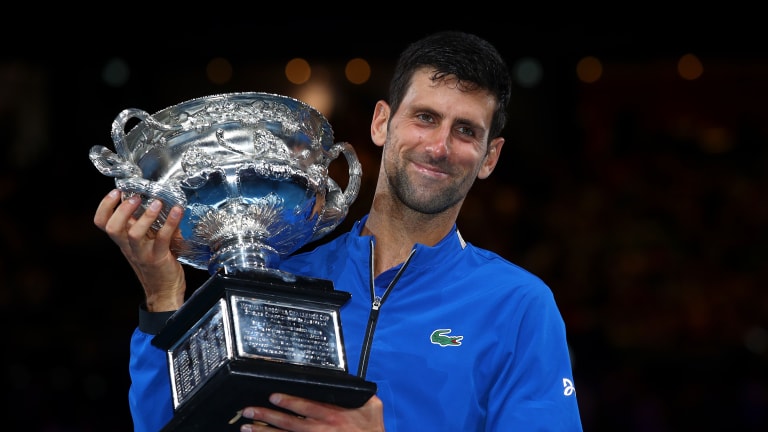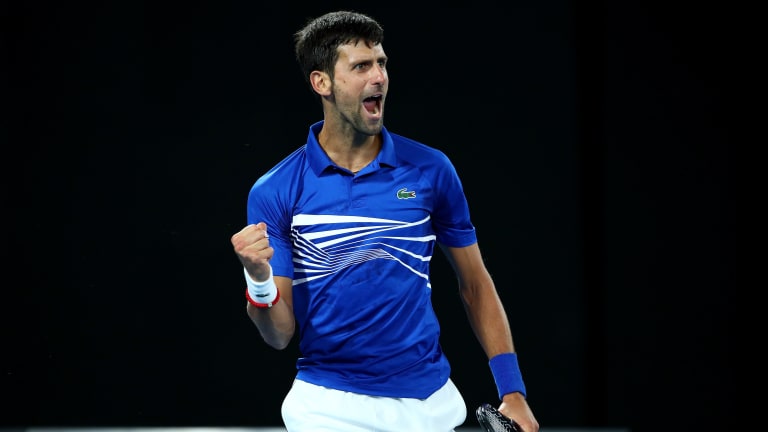How Djokovic might be able to surpass Federer and Nadal historically
By Steve Flink Jan 30, 2019Roger Federer and Caroline Wozniacki step out at the Masters: “So much tradition”
By Baseline Staff Apr 13, 2025Richard Gasquet given Monte Carlo wild card 20 years after breakthrough win over Roger Federer
By Ed McGrogan Apr 03, 2025Wolfgang Puck: The biggest tennis fan in the kitchen?
By Mitch Michals Mar 12, 2025Serena Williams, Roger Federer, Aryna Sabalenka and pickleball all featured during Super Bowl LIX
By Liya Davidov Feb 13, 2025Roger Federer’s Wimbledon-winning racquet sells for more than $100,000 in tennis auction
By Liya Davidov Feb 10, 2025Roger Federer explains tennis scoring, On logo to Elmo in Super Bowl ad
By Baseline Staff Feb 10, 2025Roger Federer’s Wimbledon winning racquet currently up for auction
By Liya Davidov Jan 28, 2025Henry Bernet, Australian Open junior champion, takes inspiration from fellow countrymen Roger Federer and Stan Wawrinka
By Associated Press Jan 25, 2025The best tennis fashion moments of 2024: Federer & Nadal for Louis Vuitton, Kostyuk's viral Wimbledon dress and more
By Stephanie Livaudais Dec 14, 2024How Djokovic might be able to surpass Federer and Nadal historically
The world No. 1 just won his third major in a row at the Australian Open, and he is playing the best tennis of his career.
Published Jan 30, 2019
Advertising
At this time last year, Novak Djokovic stood significantly behind Roger Federer and Rafael Nadal on the list of the most prolific champions ever at the major events, and slightly beneath Pete Sampras. With his 12 Grand Slam tournament titles, Djokovic was eight behind the Swiss Maestro, four back of the redoubtable Nadal, and he trailed Sampras by two. He had not taken a major since collecting his fourth in a row at the 2016 French Open. His mind was muddled. His elbow was ailing. He was simply not the essential Novak Djokovic we had marveled at for so long, not the same inexhaustible individual who had dominated tennis comprehensively from the start of 2015 into the middle of the following year, when he was victorious at five of six Grand Slam tournaments.
But since the middle of 2018, Djokovic has reinvented himself, surpassing all of his rivals, playing the game once more as only he can, leaving audiences gasping at his singular skills. He has swept the last three majors in succession, and now he has on three occasions garnered three or more majors in a row, a record no other man has matched. He realized that extraordinary feat in 2011-2012 when he was victorious at Wimbledon, the US Open and the Australian Open; going one better in 2015-2016, he took four in a row (and established himself as the first man to do that since Rod Laver won his second Grand Slam in 1969); and now has commenced his 2019 campaign with his third “Big Four” crown in a row.
And so the battle for all-time supremacy at the majors among the men has been altered decidedly. Federer remains at 20, Nadal has climbed to 17, while Djokovic has moved past the great Sampras into third place with 15 of these prestigious prizes. No longer is Federer safe at the top. Nadal is now in tenuous territory at No. 2 on the ladder. And Djokovic is so sharply focused on the goal of getting to No. 1 on the list—and he is playing such an inspiring and unassailable brand of tennis—that only a fool would dismiss his chances of eventually surpassing both Nadal and Federer.
At the Australian Open, Djokovic signaled to his chief rivals and the tennis world at large that his pursuit of history’s highest honors is as fierce and targeted as it has ever been. He capped off the fortnight in Melbourne majestically, raising his career winning record over Nadal to 28-25 by obliterating the Spaniard, 6-3, 6-2, 6-3. He made a mere nine unforced errors across three sets, totally dictated from the backcourt in rally after rally, and did not lose his serve in the match. In fact, he faced only one break point and won 56-of-69 points on serve, dropping an average of one point a game on his delivery. In my view, that performance was the best Djokovic has ever given on a big occasion, and clearly the finest major final he has ever played. It was both flawless and flamboyant. It was nothing less than astonishing.

How Djokovic might be able to surpass Federer and Nadal historically
© Julian Finney/Getty Images
Advertising
Lifting his game up to that almost unimaginable level has set Djokovic up for a stirring 2019 season. After he won that record seventh men’s title in Melbourne, Djokovic was refreshingly candid about his goals for the future and the depth of his determination to achieve preeminence on the stages of lasting consequence.
He said, “I am aware that making history of the sport that I truly love is something special. Of course it motivates me. Playing the Grand Slams and the biggest ATP events is my utmost priority in this season and the seasons to come. How many seasons are to come? I don’t know. I’m trying not to think too much in advance. I do want to definitely focus myself on continuing to improve my game and maintaining the overall well being that I have—mental, physical, emotional —so I would be able to compete at such a high level for the years to come, and have a shot at eventually getting close to Roger’s record. It’s still far.”
Indeed it is. But, having thought a lot about this lately, after following the trajectory of Djokovic’s career closely, and examining his future alongside what might be ahead for Federer and Nadal, I believe Djokovic has a good chance to finish ahead of his two chief rivals. That will depend largely on exploiting every opportunity he has over the next couple of years, piling up the big titles one by one over that span, and making a concerted effort to reach at least 18 and perhaps as many as 20 by the end of the 2020 season. That would mean securing three to five of the next seven Grand Slam tournaments. I see no reason why he can’t get that done.
One of the most critical majors of his career will be the next one. Djokovic has won the French Open only once. It will be an imperative for him to prevail again on the red clay of Roland Garros in June. Not only would that allow Djokovic to establish himself as the first man since Laver 50 years ago to take all four majors at least twice, but it would put him within one Grand Slam title of Nadal. If Djokovic does not make that happen, Nadal would almost inevitably rule at Roland Garros for the twelfth time. Nadal would then be three majors ahead of Djokovic. The Serbian knows that would be a must win for him.
I believe Djokovic will beat Nadal at the French Open if they collide. He has one win over a struggling Nadal in the 2015 Roland Garros quarterfinals, but he has lost two finals to his old rival, one epic semifinal in 2013, and three more contests with the Spaniard in Paris over the years. No one would dare dispute that Nadal is by far the greatest clay-court player in the history of the game, but the fact remains that Djokovic has defeated Nadal on clay seven times. Djokovic is the ultimate all-surface player in tennis, even more comfortable and competent across the board on different kinds of courts than either of his chief rivals, and the single most flexible and adaptable player of them all.
Perhaps clay is his tallest challenge, but Djokovic spoke about that in Melbourne.
He said, “Obviously I have to work on my clay-court game a bit more specifically than I have last season to have a shot at the title in Paris. The ultimate challenge there is to win against Nadal. Then you have Thiem and Zverev. Roger is probably going to play. You have a lot of great players that on clay can challenge me or anybody else.”

How Djokovic might be able to surpass Federer and Nadal historically
© 2019 Getty Images
Advertising
If Djokovic can rule in Paris, he would need to succeed at either Wimbledon or the US Open to be at 17 by the end of 2019. That is very likely to be the case. If he won Wimbledon on top of Roland Garros, he would then be going for the Grand Slam at the US Open. That would be asking a lot of himself, and Djokovic might just pull it off. I am projecting that he wins either Wimbledon or the Open, but not both.
In 2020, therefore, Djokovic would be well positioned to close the gap even more with Federer—assuming that the Swiss does not win Wimbledon this year. That might be Federer’s last best chance to win a major. He will be 38 in August, and he has not been beyond the quarterfinals of the last three majors. At Wimbledon, he will be in his most favorable setting on the grass, but coming through on those lawns would still be a tall and perhaps elusive order.
Djokovic could win at least two and possibly three of the four biggest tournaments in 2020. To be sure, we will find out by then if the enigmatic Alexander Zverev is ready at last to strongly contend for a major, and discover if others will come to the forefront. Stefanos Tsitsipas will make his presence known at the remaining majors this year after his surge to the semifinals at the Australian Open. But it might not be until 2020 or beyond that he is ready to win one of the premier titles. The likes of Daniil Medvedev, Karen Khachanov, Borna Coric and Denis Shapovalov could well be ready to threaten the game’s hierarchy by then, as will others.
But Djokovic will be awfully hard for any of them to beat when the stakes are highest. The way I look at it, he should win four or five more majors between now and the end of 2020. If he manages to capture five, he would be at 20, and as long as Federer does not pull off a spectacular run somewhere, and if Nadal attains no more than one major somewhere along the line, Djokovic would almost inevitably secure one more major in 2021, and possibly two. He will not turn 34 until that spring. By every barometer, he is a young man physically for his age. He has taken exceedingly good care of his body. And now he is driven more than ever before to go after the majors zealously, to win one after another with an eye towards the ultimate prize of standing alone at the top of the list.
I will give him five more majors out of the next seven. If that is the case, he will make an immense push in 2021 to win at least one more. If he does not get there, he would go full tilt after the 21st in 2022 as he approaches and then turns 35. He can realize that feat. I believe one way or another, he will make it to 21 and perhaps 22.
It is not difficult to envision Djokovic amassing a cluster of additional majors, as long as he remains healthy and avoids serious injuries like the elbow ailment that harmed him substantially over the second half of 2016 and all the way into the early stages of 2018. Barring any long absences from the sport, knowing how fully committed he is to hitting such an important milestone, carefully assessing it all, Novak Djokovic in my view is going to break Roger Federer’s record. You read it here first.

How Djokovic might be able to surpass Federer and Nadal historically
Advertising
This Week on Tennis Channel Plus:
WTA St. Petersburg: Starting Monday, Jan. 28 at 5 a.m. ET, catch live coverage of the St. Petersburg Ladies Trophy featuring Australian Open finalist Petra Kvitova and Maria Sharapova.
WTA Hua Hin: Top seed Garbine Muguruza headlines the field from Hua Hin. Watch every match of the Thailand Open, starting Monday, Jan. 28 at 3 a.m. ET.